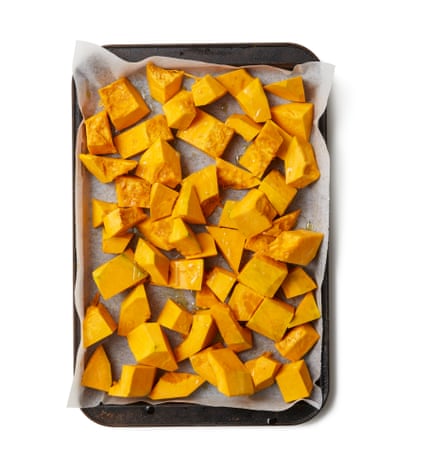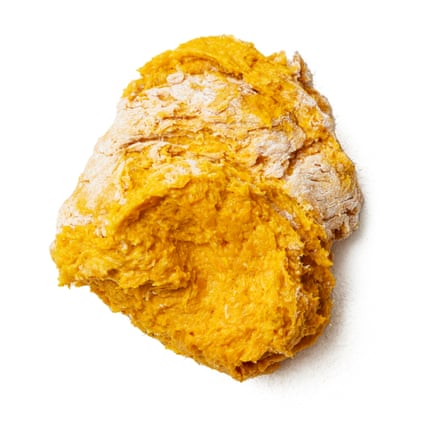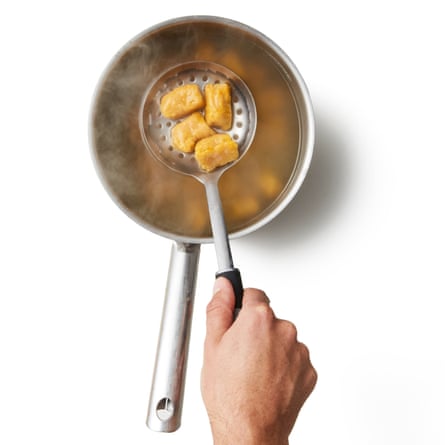Felicity Cloake
If there’s one compensation for the loss of summer’s glossy harvest, it’s the sweetness of so many autumn vegetables – most notably, of course, the pumpkins and winter squashes that have become indelibly associated with Halloween. A relatively recent addition to the European menu, they represent a welcome rush of sugar among all the bitter greens and starchy root vegetables that will inevitably dominate our diets over the next few months.
According to Anna Del Conte, pumpkin gnocchi, a more colourful and frivolous take on the potato-based version, are a speciality of Veneto and southern Lombardy, where, presumably, they would generally be served as a primi piatti before the main event; they also pair beautifully with savoury game stews, spicy sausages and sauteed mushrooms, though. They are, however, quite enough on their own, tossed in plenty of butter. And, frankly, what isn’t?
The squash
Though it generally turns up on menus as pumpkin gnocchi, possibly due to the word “squash” conjuring up visions of bland and watery marrows, you would be well advised not to try this with an actual pumpkin, unless you’re very sure of the variety. According to Janet Macdonald’s authoritative guide, Pumpkins & Squashes, “pumpkins are the round jobs with delicate or bland-tasting flesh, almost always orange coloured and more or less spherical”, while winter squashes tend to be denser, with a “nutty and sometimes almost sweet taste”. For this recipe, you want as much flavour and as little water in your gnocchi as possible, which strongly suggests the use of a winter squash.
River Cafe chef Joe Trivelli writes that they’re best made with “a dry, sweet [variety]. Butternuts don’t tend to work as well.” Recommendations include the blue-skinned crown prince, the dark green Italian delica or Japanese kabocha, and the red onion, or kuri, squash. Sadly, few of those are available in your average British supermarket, but if that’s your only option, don’t despair – I make some very satisfactory gnocchi out of butternut squash following Steve Farrow’s recipe for The Wine Society (excellent wine pairing recommendations, too).
If you want to guarantee sweetness, you may wish to follow Anna Del Conte’s suggestion of mixing butternut or kabocha with the same amount of sweet potato as the closest thing “to the spicy sweetness and moist texture of a northern Italian pumpkin”. That said, if you, like one commenter on my Instagram, find squash too sugary for your taste, you may like to follow Trivelli in mixing it with roughly equal amounts of white potato, which gives his gnocchi a more subtle sweetness – still unmistakably there, but as a hint, rather than the dominant note.
Unfortunately, unless you’re very lucky with your squash, you’ll need to bake it before use, to get rid of as much moisture as possible, yet without drying it out so much that you’re unable to blend the flesh into a puree. This may be why chef Stephen Bull’s book Classic Bull suggests covering the baking dish, but although this keeps the pumpkin soft, it does trap moisture, making his next step, of reducing the subsequent puree in a hot pan, very necessary. Better to bake them uncovered, and at a relatively moderate heat, and then reach for the frying pan only if the results are still very liquid.
The dry stuff
It’s useful to understand that the more flour you add to gnocchi dough (up to a certain point), the easier it will be to work with. The trade-off, however, is that it will also be stodgier and taste less of pumpkin (or ricotta, or potato, or whatever else you put in there). Even as someone who cannot be persuaded to see stodge as a pejorative term, I must concede that pumpkin gnocchi are better when they actually taste of pumpkin (or squash – you get my meaning), so I’ve used as little flour here as practical. The consistency of soft mashed potato is roughly what you’re aiming for: Joe Woodhouse has some sensible advice in his new book, Your Daily Veg: “I like to pull off a piece of the dough and cook it before shaping to test the flour ratio, as all pumpkins are not made equal and some retain more water than others. If the gnocchi floats to the top and holds together, then I carry on. If it breaks apart or is too loose, then I knead in another 50g of flour and try again until it holds together.”
Del Conte is the only one to add baking powder to the mix in her book Vegetables all’Italiana, but I like them more custardy and dense, so I’m going to omit it; if you’d prefer a more airy result, try adding a teaspoon along with the flour. (You can use very finely milled “00” flour, if you like, as Trivelli recommends in his book The Modern Italian Cook, but with such a small amount, only the most refined of palates would be able to tell the difference between that and what is sold in the UK as plain flour.)
The liquid
Farrow adds ricotta to his gnocchi mix, which, while diluting the flavour, gives them a lovely lightness. I want mine to be as emphatically flavoured as possible, so I won’t be including any, but it is a great idea if you have a yen for a milder and creamier dumpling. The classic binder, however, is egg, often used whole, but I prefer Bull and Richard Corrigan’s yolk-only approach, which cuts out the boring, watery white altogether.
The recipe from The Silver Spoon uses almost four times as many eggs as Trivelli’s and twice as many as Del Conte’s. Against my better judgment, I follow it to the letter – after all, this is “the bible of authentic Italian cooking” – and end up with a mixture so liquid that, when it’s dropped into a pan of boiling water with a teaspoon, as the directions suggest, it dissolves into a froth. It doesn’t seem to be a detail lost in translation, if the account by Erika Cartabia on her La Tana del Coniglio blog is anything to go by – “In my opinion,” she writes, “there was some error in the dosage of the flour!” This is a lesson to all gnocchi makers to trust your instincts; only you know how wet your puree is, and how much flour and liquid it will require.
The flavourings
I’m sad the Silver Spoon recipe doesn’t work out, because it includes crushed amaretti biscuits, a detail that reminds me of some delicious porky tortellini I was taught to make in Bergamo. If you happen to have some biscuits in need of using up, and don’t fancy trifle, try adding some to the mixture below instead of some of the flour. Here, however, I’ve stuck with the classic nutmeg, along with Bull’s dash of cinnamon to bring out the sweetness of the squash, and a good grating of parmesan to balance things out. (Other hard cheeses will also do the job.)
The shaping and accompaniment
Bull and Del Conte both pipe the dough into the pan, but I find it easier to roll my slightly more robust version into sausages and cut them individually. If you’d prefer to pipe, by all means do that, chopping off each gnoccho with a wet knife as you go.
I strongly feel that the flavour of these gnocchi is improved by a few minutes in a hot, buttery pan, to brown the sides, rather than just pouring a little melted butter (or Bull’s cream) over the top. You could add garlic and chilli, too, as Trivelli does, along with chicken livers; make a vivid, green spinach-and-parmesan sauce, as Woodhouse suggests; or toss your gnocchi with the cinnamon, sugar and parmesan butter that Del Conte says is the classic Veneto dressing. Or just go with the usual torn sage leaves and butter, because, frankly, they don’t really need anything more.
Perfect pumpkin gnocchi
Prep 25 min
Cook 45 min
Serves 4 as a first course
700g pumpkin or squash, preferably a drier variety such as crown prince, kabocha or delica
Oil, to grease
100g plain flour, plus extra for dusting
30g parmesan, grated, plus extra to serve
¼ tsp nutmeg
¼ tsp cinnamon
½ tsp salt
1 egg yolk
50g butter
1 small handful sage leaves (optional)

Heat the oven to 180C (160C fan)/350F/gas 4. Peel the squash, and deseed (I find a serrated spoon useful, if you have one), then cut the flesh into large chunks.

Put these on a lightly greased baking sheet and roast, turning once halfway, for 35-40 minutes, until tender but not coloured.

While the squash flesh is still warm, puree or mash it, or pass it through a potato ricer – you should have about 500g (if there’s a lot more, you’ll probably need to add more flour in the next step; if a lot less, reduce the flour accordingly). If the puree looks very wet, heat a large frying pan, either lightly greased or nonstick, on a medium-high heat, add the puree and cook, stirring regularly, for about five minutes, until it looks dry and slightly darker in colour. If it’s already fairly dense, like mashed potato, you can skip this step.
Tip the puree into a large bowl, then add the flour, cheese, spices and salt, followed by the egg yolk. Stir until you have a soft but coherent dough – it should hold together, so add more flour if necessary.

Lightly dust a work surface with flour and dust a tray with more flour. Take a handful of the gnocchi mixture and roll it into a thick sausage about 2cm in diameter.

Cut this into roughly 2cm lengths and lay them on the floured tray, keeping them spaced out. Repeat with the remaining dough.

Bring a large, deep pan of lightly salted water to a boil. Cook the gnocchi in batches until they bob to the surface, then scoop out and drain in a sieve, tossing to ensure they don’t stick together.

Melt the butter in a large frying pan on a medium-high heat, then tear in the sage leaves. Add the drained gnocchi and cook, stirring gently and tossing, until coated in butter and lightly coloured all over.
Serve with the butter poured over the top, another grating of nutmeg and a little more parmesan.
Courtesy: theguardian






